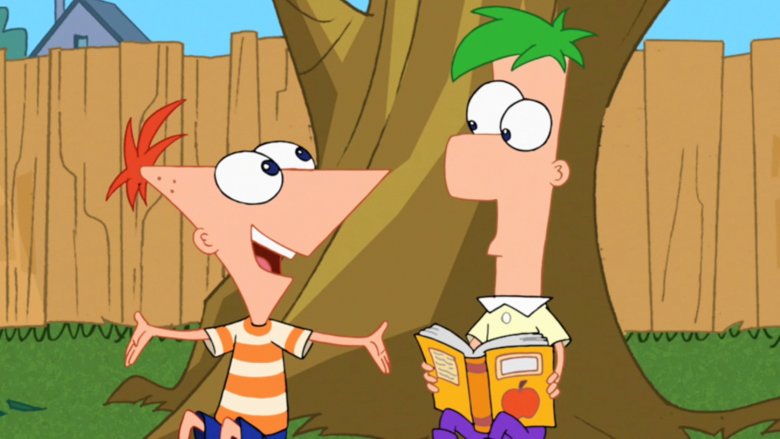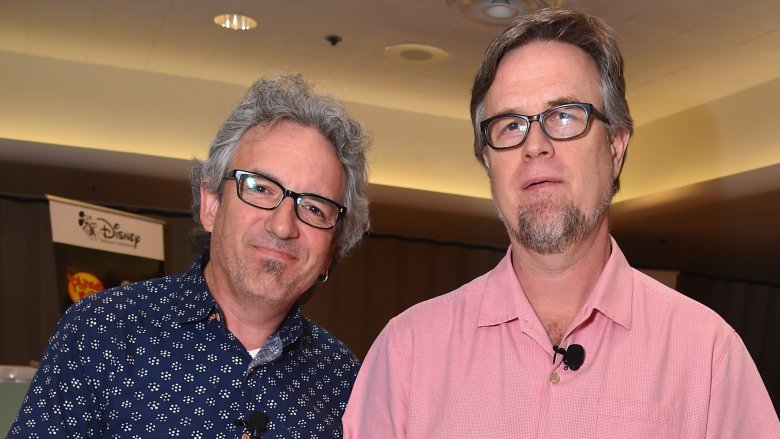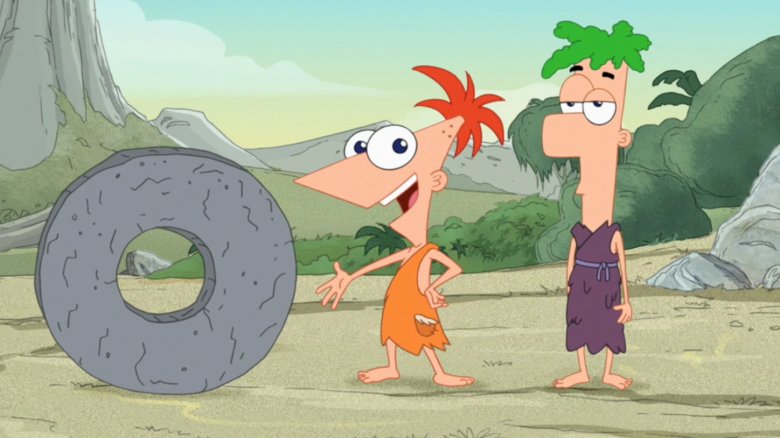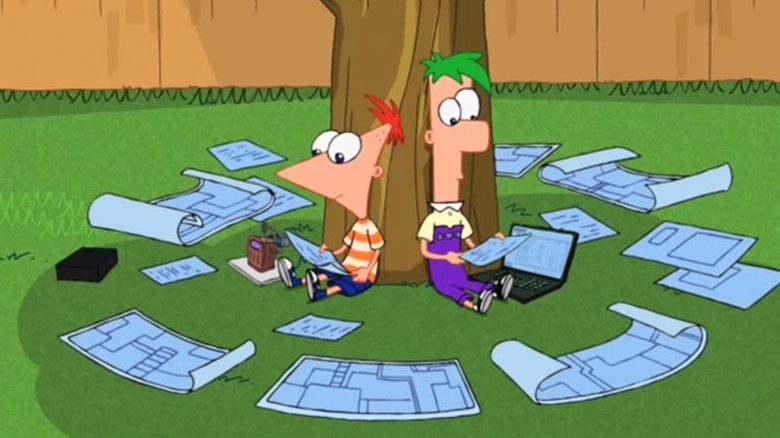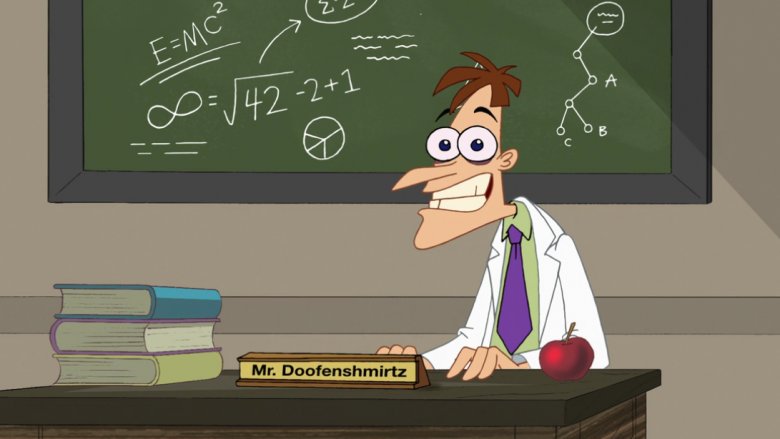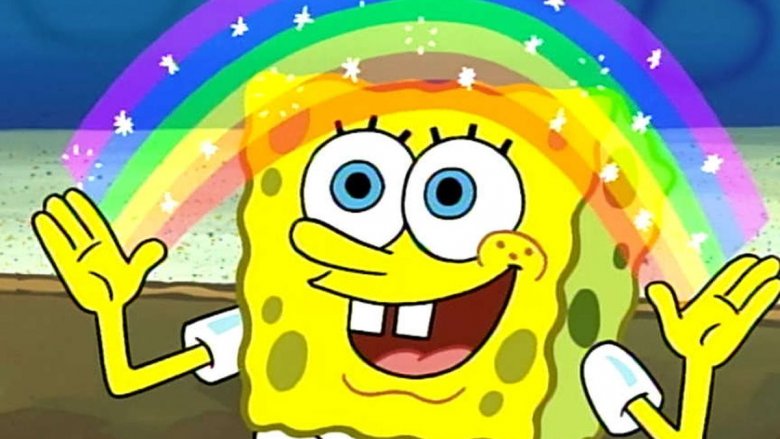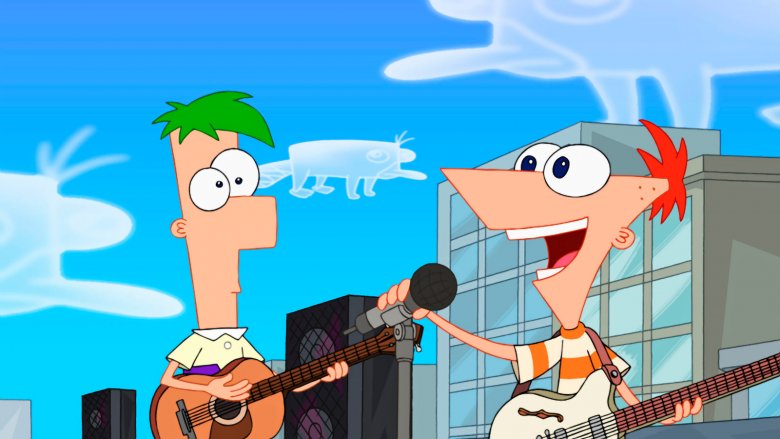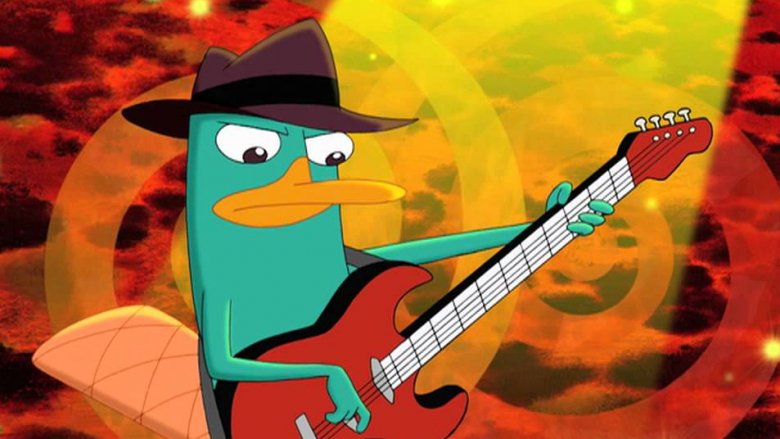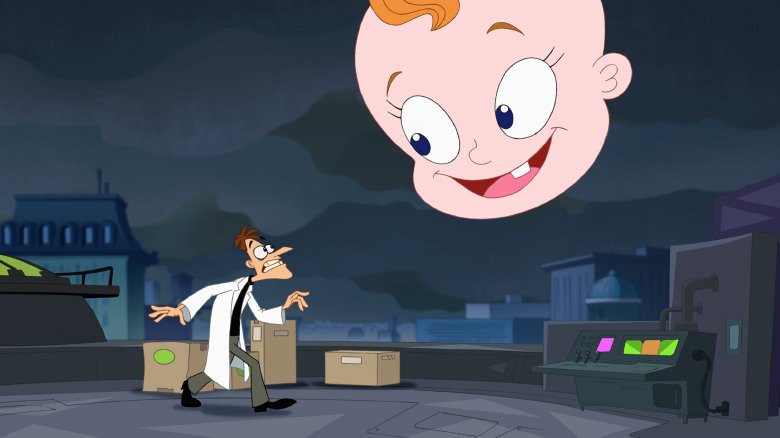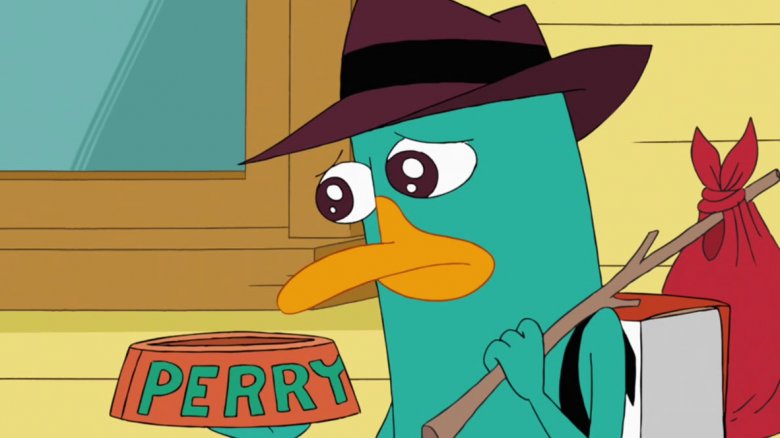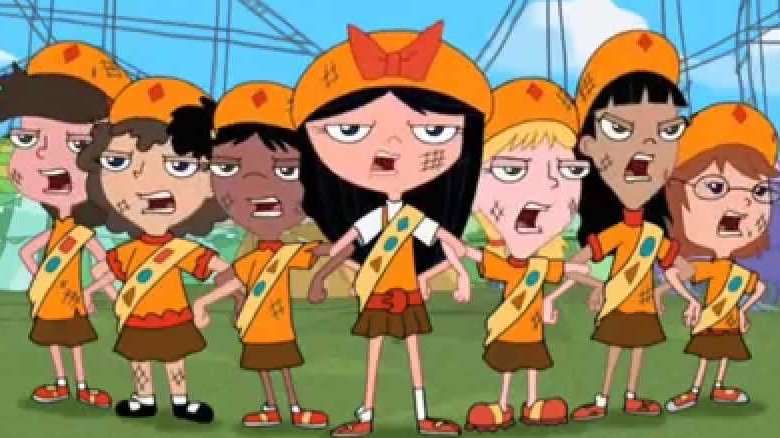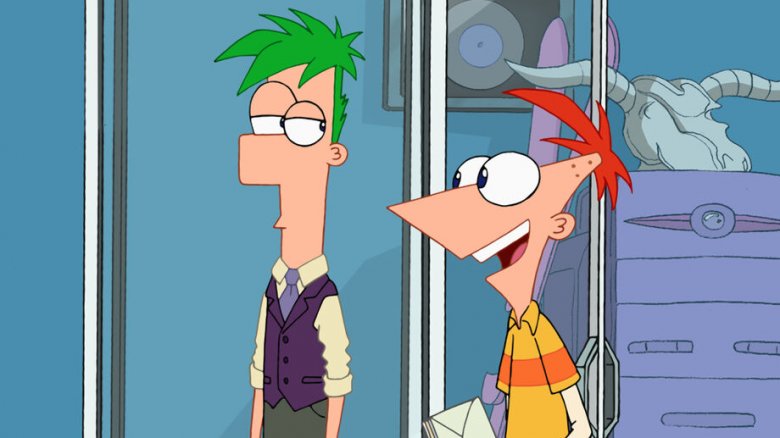The Untold Truth Of Phineas And Ferb
"There's 104 days of summer vacation," so went the Phineas and Ferb theme song, and "there's a whole lot of stuff to do before school starts." That's the premise, in a nutshell of the 2007–2015 Disney Channel series.
Over the course of the show, Chatty Phineas (voiced by Vincent Martella) and his quiet stepbrother, Ferb (Thomas Brodie-Sangster), aimed to make the most of every day of their summer break by planning and executing their ambitious "Big Ideas." At various times, they built a biosphere, made shoes that provided cheetah-like speed, searched for the "Lake Nose Monster," and built an animal translator — just your average summer kid stuff. Older sister Candace (Ashley Tisdale) forever tried to bust them, but much to her frustration, evidence of their tomfoolery always dissipated before the parental units showed up. Meanwhile, the kids had no idea that their pet platypus, Perry, had a secret life as a secret agent, forever spoiling the efforts of the evil Dr. Doofenshmirtz to cause chaos throughout "the Tri-State Area."
Phineas and Ferb was a big world of big fun, and here's everything you might not have known about the beloved series.
How Phineas and Ferb's creators first met
Phineas and Ferb co-creators Jeff "Swampy" Marsh and Dan Povenmire both took a non-traditional path to television animation. "The only real art training I received was some architectural rendering," Marsh told Variety 411. "I didn't really get into animation until I was about 28." After quitting his job in marketing for a computer company, Marsh put a portfolio together and miraculously got a job as a layout artist for The Simpsons. As for Povenmire, he attended film school and "spent some time working in the live-action side of things, until a long dry spell when there was no work." He took a job on an animated show, as he'd "always been an artist." He also landed a gig on The Simpsons, working as a layout artist in the same room as Marsh. The duo only really started working with each other when they were hired as a writing team on Nickelodeon's Rocko's Modern Life.
It took a long time for Phineas and Ferb to hit TV
One night in the mid-'90s, artist-turned-writer Dan Povenmire drew a triangle-headed kid with huge eyes on some butcher paper acting as a tablecloth at a restaurant in Pasadena, California. And lo, Phineas was born, and when Povenmire showed the character to his Rocko's Modern Life writing partner, Jeff "Swampy" Marsh, the pair excitedly developed an entire fictional universe that would become the pitch for Phineas and Ferb. Povenmire and Marsh then tried to sell it to various TV outlets ... and failed. "We pitched it to four different places. We'd get real close, they'd say no, so we'd put it back on the shelf for a couple of years," Povenmire told Animation World Network. Years passed, and Marsh moved to England, and Povenmire took a job on Family Guy. Then, one day in the 2000s, Disney called Povenmire to tell him that they'd changed their mind and would like to make Phineas and Ferb into a show. When the series premiered in late 2007, nearly 16 years had passed since Povenmire made his first drawing in that restaurant.
It drew inspiration from two classic TV shows
Phineas and Ferb found the perfect balance between the familiar and the dazzlingly original. Kids across the world (and adults) can relate to squeezing every bit of fun out of summer vacation. Plus, the notion of a secret agent platypus is lots of fun, and who isn't delighted by Phineas and Ferb's absurdly large projects? In other words, the show was incredibly creative, but what triggered this super inventive series?
Well, Phineas and Ferb creators Dan Povenmire and Jeff "Swampy" Marsh took inspiration from two classic yet wildly different children's shows: The Adventures of Rocky & Bullwinkle and Sesame Street. How so? Well, almost every episode includes a Phineas and Ferb project, a subplot with Candace trying in vain to get someone to believe her reporting of her brothers' exploits, and a Perry the Platypus adventure — a lot to pack into just 11 minutes. "The reason we wanted to several stories at once is Rocky & Bullwinkle," Povenmire told Slate. "But they did it as a an anthology, where they'd check in on one story and come back."
And here's where Sesame Street comes in. "Big Bird had this big, furry, mastodon-type character that only he would see," Povenmire added, referring to Snuffleupagus, "and then he would, like, go to try to find other people to get them to bring them back and show them the Snuffleupagus," who would then disappear, because he was initially an imaginary friend. So if you blend those two TV shows together, presto, you get the plot for most episodes of Phineas and Ferb.
School drools, summer rules
Of all the countless shows in TV history about the lives of kids — both animated and live-action — they've almost exclusively focused on the characters' exploits at school. For example, there's Doug, Hey Arnold!, Saved by the Bell, Degrassi, and the list goes on. Phineas and Ferb is the rare, refreshing example of a show about kids that takes place during the summer. In fact, it's set exclusively in the summer, and just one summer at that, as the series' entire run plays out over a single span of "104 days of summer vacation." And that was creators Dan Povenmire and Jeff "Swampy" Marsh's "Big Idea."
"The whole thing came about because we didn't want to deal with school," Marsh told Animation World Network. "We've seen it over and over again in too many shows — there's nothing fresh to it." So, he and Povenmire thought about their memorable childhood summers, as opposed to the routine drudgery of school. "We remember growing up being kids. Every summer day we'd go out and do something: dig a trench, or build a tunnel, fort, or a tree house." Beyond that, the show was meant to pay homage to a less technologically-oriented time period. "We grew up in a time when there was minimal TV and no video games," Marsh told Variety 411. And as Povenmire explained, "We wanted to do a show that celebrated a kid's imagination."
Phineas and Ferb was supposed to be Disney's answer to SpongeBob
While the schedules of competitors like Cartoon Network and Nickelodeon are traditionally full of silly, proudly weird cartoons (e.g. Uncle Grandpa, Regular Show, Sanjay and Craig, The Fairly Odd Parents), that doesn't hold true for the Disney Channel. But the network made attempts to compete in that sector with Phineas and Ferb. A 2010 New York Times feature about the show proclaimed that Disney was "certainly trying" to turn Phineas and Ferb into "the new SpongeBob," complete with "theme parks tie-ins, the movies, and the merchandising blitz." That shift into "a hard sell for Phineas and Ferb" included characters walking around at Disneyland, an influx of toys and merchandising to Target and Wal-Mart, the launch of a monthly magazine, and even a Phineas and Ferb edition of Kraft Macaroni and Cheese.
However, Disney's other attempts to dominate the kiddie TV universe by expanding the Phineas and Ferb media footprint didn't quite work out. A spinoff called Take Two, in which Phineas and Ferb interviewed live-action celebrities, lasted just one season. A theatrical movie was also in the works around 2011, but it wound up delayed for years. Fortunately, it'll premiere on Disney+ sometime after the streaming service launches.
The shape of things
Probably because they don't have to operate through a lens of realism, cartoons can be as visually zany as they like. Characters are often caricatures and don't look anything like real living beings. Actual mice don't look like Mickey Mouse, humans aren't four-fingered and yellow skinned like The Simpsons, and the shapes of the characters' heads and bodies on Phineas and Ferb don't appear anywhere in the natural world.
That's a specific choice, based on a style philosophy that co-creator Dan Povenmire says he learned from Matt Groening, creator of The Simpsons (where he once worked). "All the main characters are based on geometric shapes. Phineas is a triangle, Ferb is a rectangle, Candace and Isabella are half circles," Povenmire told Variety 411. "We tried to create characters that kids would easily be able to draw themselves. We also created characters that would be very recognizable even from a distance. Matt Groening once said that when you are designing characters, they should be recognizable in silhouette."
As for the show's unique color palette, co-creator Jeff "Swampy" Marsh explained, "The idea at the end of the day was candy. The characters are so bright and candy-colored, and our backgrounds are a much more realistic depiction of the world: the soft green of the grass, the natural woods for the fence. In order for all of the stuff that they do to work, their world needs to be grounded in reality."
Phineas and Ferb was the most musical show on TV (besides Glee)
Phineas and Ferb creators Dan Povenmire and Jeff "Swampy" Marsh live the dream in that they make cartoons for a living, but they're still a couple of dudes, and the thing dudes most want to be is musicians. "We both want to be rock-and-rollers anyway," Marsh told Animation World Network. "Dan's had a band for years, and I was in one once." Fortunately for them, Phineas and Ferb scratched their musical itch and allowed them the chance to express themselves through the power of song. "Phineas and Ferb gave us a chance to write a song for every single episode, starting with the second episode, 'Flop Starz,'" Povenmire said. They played the tune from that installment for Disney executives, who liked it so much that they asked Povenmire and Marsh to make an original song for every episode going forward.
Those songs — sometimes sung by a character, sometimes played over a montage, and in any number of musical styles — were created in a very specific way. At the end of the work week each Friday, Povenmire, Marsh, and a musically inclined staff writer would write the song, then play it over the phone into show composer Danny Jacob's answering machine. "Literally by like Monday or Tuesday, we'd have some semblance of a demo track," Marsh told Slate.
Where did the giant floating baby head come from?
Most animated shows are produced in the same way. Generally speaking, the writers write scripts, and then storyboard artists draw a series of panels based on those scripts, which are then turned into an animated final product. But that isn't how Phineas and Ferb operated. Instead, the staff and storyboard artists worked simultaneously. Co-creator Dan Povenmire told Slate that he utilized that method because it's how it was done on his previous show, Rocko's Modern Life. But why? Well, it evidently leads to more and better visual jokes, which is important on a show with two virtually silent main characters (Ferb and Perry the Platypus). "If you want a lot of visual humor, the way to do it is have visual people do it," Povenmire said. "Ferb and Perry would have just disappeared in scripts."
One of the funniest (and bizarre) running jokes across the series was the sudden appearance of the smiling head of a baby ... only gigantic and disembodied. That's the result of the freewheeling visual storytelling process. As Povenmire told the St. Petersburg Times, the head "came from one board panel drawn by Mike Diederich, and one of our directors, Rob Hughes, thought it was hilarious and made a whole bit about it." Sure, but what does this weird gag actually mean? "We try not to think too much about the floating baby head," Marsh added. "It makes us laugh, 'nuff said."
Forget everything you know about Perry the Platypus
While primarily a show about two kids having fun, Phineas and Ferb also offered up the espionage-based exploits of Agent P, a.k.a. Perry the Platypus, Phineas and Ferb's chattering, blank-faced, pet platypus. The Phineas and Ferb "Big Idea" main plotline and Agent P's takedown of Dr. Doofenshmirtz's schemes often intersected, so that all tracks, but why did the series incorporate an animal as obscure as a platypus? Well, because it's obscure, the showrunners could do whatever they wanted with the character. "We feel like we can own this animal," co-creator Jeff "Swampy" Marsh told Variety. "Few kids have a specific image in their mind of what a platypus is before seeing Phineas and Ferb."
According to Marsh, there was another benefit of using a platypus. As he explained, "We wanted to pick an animal that kids couldn't go pick out at a pet store and beg for." Obviously, Marsh was alluding to "pet fads" of the past, such as how countless people adopted (and then abandoned) Dalmatians after the release of the 1996 live-action 101 Dalmatians.
Phineas and Ferb had two spinoffs that spun out
While one Phineas and Ferb spinoff, Take Two, aired from 2010 to 2011, it didn't exactly set the world on fire. But it got far more of a chance than a couple of other potential Phineas and Ferb offshoots received. In 2010, The New York Times reported that Disney was considering a spinoff about the Danville chapter of the Fireside Girls, those intrepid Girl Scout-like youngsters (Milly, Katie, Ginger, Gretchen, Holly, Adyson, Isabella, et al.) who frequently helped Phineas and Ferb execute their grand and absurd plans. That project, unfortunately, never became a standalone series.
Five years later, around the time that Phineas and Ferb aired its series finale, Disney announced a fall premiere date of The O.W.C.A. Files, a one-hour special about Agent P (Perry the Platypus) and his fellow operatives at the "Organization Without a Cool Acronym." This spinoff special is the only episode of The O.W.C.A Files to ever exist.
Welcome to the show
Imagine having some creative talent and being such a huge fan of a TV show that when you reach out to the people who make that show, they hire you. That happened to a Canadian artist identified only as "Ashley," and the show in question was Phineas and Ferb. While studying animation at a Vancouver art school in 2012, Ashley attended San Diego Comic-Con with one goal in mind. As she wrote on Oh My Disney, her dream was "meeting Phineas and Ferb creators Dan Povenmire and 'Swampy' Marsh to give them a drawing of Phineas and Ferb as teenagers." Ashley managed to do just that, and added that "their reaction to the drawing I gave was more positive than I expected, and something I needed to hear to boost my confidence in my art."
She didn't know the half of it. A couple of months later, Marsh found Ashley on the art forum DeviantArt, and he invited her to come visit the Disney Television Animation Studio (where Phineas and Ferb was produced). It gets even better. Two months after that, the production sent Ashley a message asking if she "would want to do some character designs for Phineas and Ferb." Soon thereafter, Ashley hit Southern California for her animation studio visit ... and first professional freelance gig.
